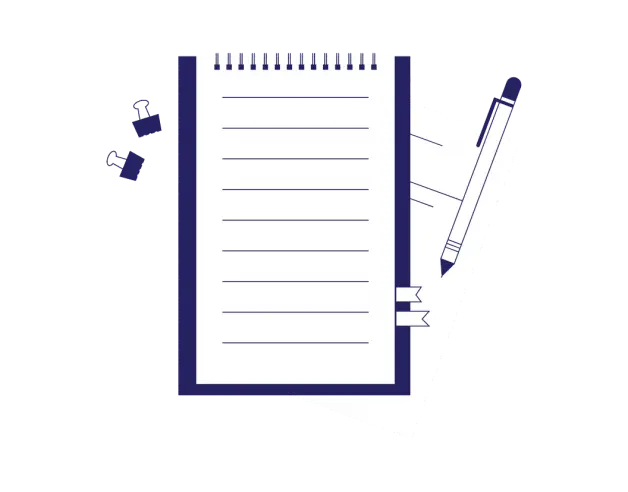
-
5-minute read
-
29th March 2023
How to Write an Interview Script
Writing an interview script, such as for a webinar or journalistic purposes, involves planning the questions and conversational flow to ensure a smooth and engaging session. Here’s a step-by-step guide to help you develop an interview script for any type of interview.
9 Steps to Writing an Interview Script
Step 1: Determine the Interview’s Objective
To write an interview script, start by determining the purpose of the interview and what information you want to get out of it – and make sure that the information is required for your intended purpose. For example, for a webinar, make sure the information is related to the webinar topic or is what the attendees are looking for.
Step 2: Research the Interviewee
There’s nothing worse than listening to an interview and realizing that the reporter didn’t do any research on the interviewee (super embarrassing!). To avoid this kind of situation, gather information about the interviewee, their expertise, and relevant background beforehand. This will help you craft targeted questions and engage in a meaningful conversation.
Step 3: Outline the Structure
Create a logical structure and outline for the interview script that allows for a natural flow of conversation. For example, you can divide the interview into sections or themes if applicable, based on the topics you plan to cover. The main point is to avoid jumping around from topic to topic or backtracking because you failed to plan accordingly.
Step 4: Icebreaker or Warm-up Questions
Begin with a few light or casual questions to establish a rapport and make the interviewee comfortable. This can help set a positive tone for the rest of the interview.
Here are some general warm-up questions that you could use at the start of an interview. Of course, try to tailor them to your interviewee to make it seem more personal.
● How are you doing today?
● Can you share a little bit about your background and how it led you to where you are today?
● What initially sparked your interest in [topic/field]?
● How did you get started in [topic/field]? Was there a specific moment or event that influenced your path in [topic/field]?
● Are there any current trends or developments in [topic/field] that you find particularly interesting or promising?
Step 6: Transition into Core Questions
After your introduction and warm-up questions, move on to the main questions that align with the interview’s objective(s). These questions should delve into the interviewee’s expertise, opinions, experiences, and insights. Make sure the questions are clear, concise, and open-ended to encourage in-depth responses.
Step 7: Follow-up Questions
Prepare a list of follow-up questions or prompts to dive deeper into specific points raised by the interviewee. These should help clarify any uncertainties and provide additional context or examples.
Step 8: Closing Questions
Toward the end of the interview, ask concluding questions that wrap up the discussion or give the interviewee the opportunity to provide any final thoughts, advice, or recommendations.
Here are some ideas for closing questions. As above, try to tailor them where possible.
Find this useful?
Subscribe to our newsletter and get writing tips from our editors straight to your inbox.
Subscribe to Beyond the Margins and get your monthly fix of editorial strategy, workflow tips, and real-world examples from content leaders.
● Do you have any final thoughts you would like to share before we finish?
● Based on our discussion today, what do you think is the key takeaway or message?
● Are there any upcoming projects, events, or initiatives you would like to promote?
● How can readers/listeners/audience members connect with you or stay up to date with your work?
● Is there anything we didn’t discuss in our conversation today that you would like to share?
Step 9: Review, Edit, and Proofread
After drafting the interview script, review and refine it for clarity, coherence, and flow. Ensure the questions are well-sequenced and aligned with your overall objective. You should also check that it’s an appropriate length for the allotted interview time.
Although it will only be you reading the interview questions during the actual interview, take the time to proofread them and add in any notes or additional relevant information. This will help you avoid making mistakes when asking the questions.
Some Things to Consider for a Webinar Interview:
Start With an Introduction
Begin the interview with a warm welcome and introduce the interviewee to your audience. You should include a brief overview of the interviewee’s background and expertise.
Audience Engagement
Incorporate opportunities for audience engagement during the interview. This can include taking pre-submitted questions from attendees or incorporating live chat questions. Prepare a few audience-related questions or prompts to encourage participation.
Thank the Interviewee and Conclude the Interview
You should express gratitude to the interviewee for their time and contribution and offer an opportunity for them to share any relevant links, resources, or contact information that your attendees might be interested in.
Some Things to Consider for a Journalist Interview:
Fact-Check and Verify Information
Double-check any factual information provided by the interviewee if you plan to write an interview-based article following the interview.
Follow Ethical Guidelines
Adhere to ethical journalism practices, such as ensuring the interviewee’s consent, respecting confidentiality if agreed upon, and avoiding bias or misrepresentation. Attribute information to the interviewee where appropriate. Additionally, let your interviewee know which method you plan to use to record the interview (e.g., written notes, audio, or video recording).
Conclusions
Remember, flexibility is key during any type of interview. Be prepared to deviate from the script if the conversation takes an interesting or valuable direction. Adapt to the interviewee’s responses and engage in an organic and dynamic conversation.
And if you need help with proofreading, be sure to send the interview our way! Our editors will check it for grammar, word choice, consistency, and more. Try it out for free today.




